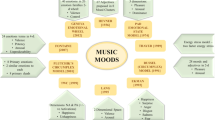Abstract
In an ambience designed to adapt to the user’s affective state, pervasive technology should be able to decipher unobtrusively his underlying mood. Great effort has been devoted to automatic punctual emotion recognition from visual input. Conversely, little has been done to recognize longer-lasting affective states, such as mood. Taking for granted the effectiveness of emotion recognition algorithms, we go one step further and propose a model for estimating the mood of an affective episode from a known sequence of punctual emotions. To validate our model experimentally, we rely on the human annotations of the well-established HUMAINE database. Our analysis indicates that we can approximate fairly accurately the human process of summarizing the emotional content of a video in a mood estimation. A moving average function with exponential discount of the past emotions achieves mood prediction accuracy above 60%.
Access this chapter
Tax calculation will be finalised at checkout
Purchases are for personal use only
Preview
Unable to display preview. Download preview PDF.
Similar content being viewed by others
References
Picard, R.W.: Affective computing. MIT Press (2000)
Kuijsters, A., Redi, J., de Ruyter, B., Heynderickx, I.: Improving the mood of elderly with coloured lighting. In: Wichert, R., Van Laerhoven, K., Gelissen, J. (eds.) AmI 2011. CCIS, vol. 277, pp. 49–56. Springer, Heidelberg (2012)
Porayska-Pomsta, K., Anderson, K., Damian, I., Baur, T., André, E., Bernardini, S., Rizzo, P.: Modelling Users’ Affect in Job Interviews: Technological Demo. In: Carberry, S., Weibelzahl, S., Micarelli, A., Semeraro, G. (eds.) UMAP 2013. LNCS, vol. 7899, pp. 353–355. Springer, Heidelberg (2013)
Conati, C., Maclaren, H.: Empirically building and evaluating a probabilistic model of user affect. User Modeling and User-Adapted Interaction, 267–303 (2009)
Darwin, C.: The expression of the emotions in man and animals. Oxford University Press (1998)
De la Torre, F., Cohn, J.F.: Facial expression analysis. In: Visual Analysis of Humans, pp. 377–409 (2011)
Kleinsmith, A., Bianchi-Berthouze, N.: Affective Body Expression Perception and Recognition: A Survey. Transactions on Affective Computing, 15–33 (2013)
Jenkins, J., et al.: Human emotions: A reader. Blackwell, Malden (1998)
Lane, A.M., Terry, P.C.: The nature of mood: Development of a conceptual model with a focus on depression. Journal of Applied Sport Psychology 12(1), 16–33 (2000)
Thrasher, M., Van der Zwaag, M.D., Bianchi-Berthouze, N., Westerink, J.H.D.M.: Mood recognition based on upper body posture and movement features. In: D’Mello, S., Graesser, A., Schuller, B., Martin, J.-C., et al. (eds.) ACII 2011, Part I. LNCS, vol. 6974, pp. 377–386. Springer, Heidelberg (2011)
Sigal, L., Fleet, D.J., Troje, N.F., Livne, M.: Human attributes from 3D pose tracking. In: Daniilidis, K., Maragos, P., Paragios, N. (eds.) ECCV 2010, Part III. LNCS, vol. 6313, pp. 243–257. Springer, Heidelberg (2010)
Beedie, C., Terry, P., Lane, A.: Distinctions between emotion and mood. Cognition & Emotion 19(6), 847–878 (2005)
Mehrabian, A.: Pleasure-Arousal-Dominance: A General Framework for Describing and Measuring Individual Differences in Temperament. Current Psychology, 261–292 (1996)
Parkinson, B., et al.: Changing moods: The psychology of mood and mood regulation. Addison Wesley Longman (1996)
Russell, J.A.: Core affect and the psychological construction of emotion. Psychological Review 110(1), 145 (2003)
Ekman, P.: Basic emotions. In: Handbook of Cognition and Emotion, pp. 45–60 (1999)
Schuller, B., Valstar, M., Eyben, F., Cowie, R.: AVEC 2012-The Continuous Audio / Visual Emotion Challenge (2012)
Metallinou, A., Narayanan, S.: Annotation and Processing of Continuous Emotional Attributes: Challenges and Opportunities. In: EmoSPACE Workshop, Shangai (2013)
Ekman, P.: An argument for basic emotions. Cognition & Emotion 6(3-4), 169–200 (1992)
Rusell, J.: A circumplex model of affect. Personality and Social Psychology, 1161–1178 (1980)
Thayer, R.E.: The origin of everyday moods: Managing energy, tension, and stress. Oxford University Press (1996)
Dietz, R., Lang, A.: Affective agents: Effects of agent affect on arousal, attention, liking and learning. In: 3rd ICTC, San Francisco (1999)
Gebhard, P.: ALMA – A Layered Model of Affect. In: 4rth International Conference of AAMAS (2005)
Bradley, M.M.: Emotional Memory: A dimensional analysis. In: Emotions: Essays on Emotion Theory, pp. 97–134 (1994)
Hanjalic, A., Li-Qun, X.: Affective video content representation and modeling. IEEE Transactions on Multimedia, 143–154 (2005)
Douglas-Cowie, E., Cowie, R., Sneddon, I., Cox, C., Lowry, O., McRorie, M., Martin, J.-C., Devillers, L., Abrilian, S., Batliner, A., Amir, N., Karpouzis, K.: The HUMAINE database: addressing the collection and annotation of naturalistic and induced emotional data. In: Paiva, A.C.R., Prada, R., Picard, R.W. (eds.) ACII 2007. LNCS, vol. 4738, pp. 488–500. Springer, Heidelberg (2007)
Kipp, M.: Anvil: The video annotation research tool (2007)
Author information
Authors and Affiliations
Editor information
Editors and Affiliations
Rights and permissions
Copyright information
© 2014 Springer International Publishing Switzerland
About this paper
Cite this paper
Katsimerou, C., Redi, J.A., Heynderickx, I. (2014). A Computational Model for Mood Recognition. In: Dimitrova, V., Kuflik, T., Chin, D., Ricci, F., Dolog, P., Houben, GJ. (eds) User Modeling, Adaptation, and Personalization. UMAP 2014. Lecture Notes in Computer Science, vol 8538. Springer, Cham. https://doi.org/10.1007/978-3-319-08786-3_11
Download citation
DOI: https://doi.org/10.1007/978-3-319-08786-3_11
Publisher Name: Springer, Cham
Print ISBN: 978-3-319-08785-6
Online ISBN: 978-3-319-08786-3
eBook Packages: Computer ScienceComputer Science (R0)




